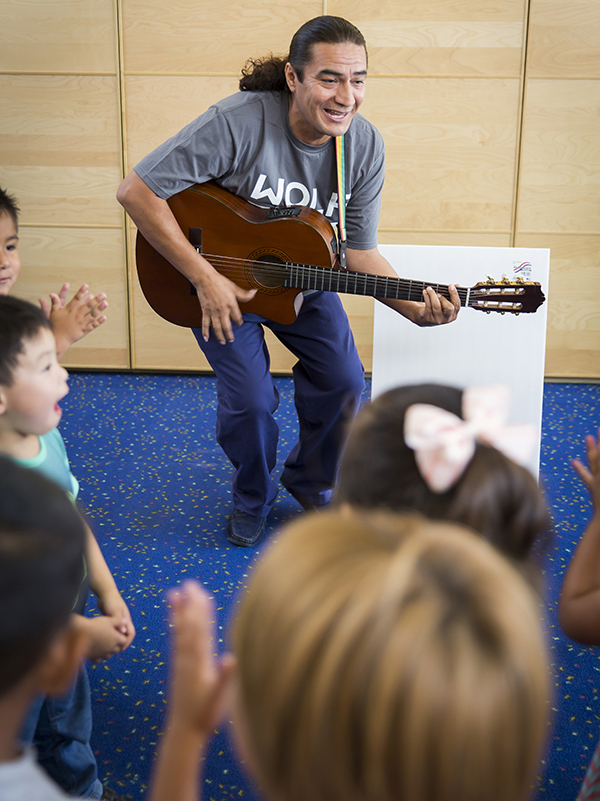The Art of Teaching

Sep 15, 2016
Wolf Trap Institute Employs Creativity in the Classroom
You’re racing toward an intersection on your way to work and the light turns from green to yellow. You’re too far away to make it through, so you stop. It’s a simple decision, one you make automatically, never missing a beat in the song on the radio that you’re singing along with.
But the child on the sidewalk? She has to think it through: Yellow comes before red. If you haven’t started to cross the street, don’t start. She has to consciously interpret the pattern, remembering what each light means and what color to expect next. Pattern recognition is a life-saving skill, and she wasn’t born with it. She had to learn it.
One of the best ways to teach preschool children about patterns involves dance. Laura Schandelmeier, a choreographer and Master Teaching Artist who has worked with Wolf Trap Institute for Early Learning Through the Arts since 2001, educates teachers in building patterns based on movements. “If the main character in a book is a rabbit,” she says, “I may work with the teacher and teach her how to choreograph a dance phrase based on the attributes of a rabbit.” The teacher surveys the class, which comes up with:
1.) Big, floppy ears
2.) Tail
3.) Paws
She then asks the children to suggest gestures for each attribute; the best are chosen and repeated, forming an A-B-C pattern. The exercise links observation (a science skill) with counting and patterning (math skills) using dance. And, since the activity is based on a book, it connects to emerging literacy.

Wolf Trap Teaching Artist Laura Schandelmeier brings arts-integrated learning into the classroom.
To reach students, Wolf Trap Institute concentrates on teachers. To do this, the Institute trains artists from a variety of fields to become Teaching Artists (TAs). They must learn to engage children in ways that are developmentally appropriate, and they must learn to speak the language of teachers. In collaboration with colleagues from diverse artistic backgrounds, they learn to forge connections between their art forms and early childhood concepts. Dancers, musicians, actors, and puppeteers all exchange ideas with one another. Then, TAs partner with teachers during eight-week classroom residencies, which leave the teachers with skills they can use throughout their careers with the hundreds or thousands of children they will instruct, producing a powerful multiplier effect.
“We invest in the professional development of our TAs to assist them in developing strong, meaningful partnerships with teachers to bring curriculum alive through the arts,” says Wolf Trap Institute Director Jennifer Cooper. “They are already experts in their art forms, however it is by teaching them to integrate arts skills with skills involving other curricula that we prepare them to be successful in addressing the needs of today’s classrooms.”
TAs also learn how and when to hand over the reins to the classroom teacher. Over the course of a residency, roles gradually shift, and by the time it ends, the teacher has the skills and confidence to use arts-integrated methods independently.
To amplify the impact of Wolf Trap Institute’s teaching methods in regions across the United States, Wolf Trap currently has Affiliate Programs and TAs in 16 communities outside the DC/MD/VA area. Additionally, to reach areas outside the immediate reach of Wolf Trap or its Affiliates, TAs travel and offer intensive one-week residencies.

In a Spanish-immersion residency, new Teaching Artist Julio Cuellar, a Bolivian-born singer/songwriter, uses music to create the loud and soft sounds of a rainstorm.
Decades of research have shown that arts-integrated learning works. “Early childhood is the most critical time for learning,” says Akua Kouyate-Tate, Senior Director of Education at Wolf Trap Foundation. “If we want to create positive change and set children up for success in later life, we need to stop thinking of arts in the classroom as a luxury. They are a necessity.”
For more information, visit wolftrap.org/institute.
Recommended Posts

“Hip Hop Harmony,” A Lesson in Adapting Musical Experiences for Young Children
Jun 11, 2024 - Education

Using Music to Boost Engagement
Jun 11, 2024 - Education

